Food in Argentina & Chile
Patagonian cuisine is identified by its striking colourful presentation and intense, rich flavours.
Hearty meat and seafood dishes flavoured with interesting spices tend to be the stars of the show, accompanied by fine wines and followed by delicious desserts.
On this page, we'll give you a taste of the food delicacies & drink specialities not to be missed, present our restaurant recommendations by location and look at dietary considerations while travelling.
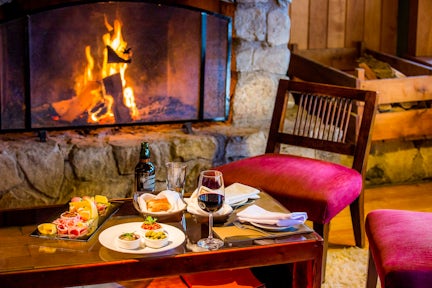
A Culinary Adventure
We think one of the best things about travel is trying the local delicacies. Here we've picked out 5 food delights not to be missed on your visit to Patagonia:
- Asado - Also known as 'parrillada', this barbecue food is the national dish of Argentina. Originating from the gauchos, or cowboys, you can expect to find beef, pork, ribs, sausages and sweetbreads hot off the fire, and it is not uncommon to see a whole lamb or pig roasting over an open fire.
- Chimichurri - The go-to condiment of Patagonia. A tangy, garlicky salsa made from parsley, onion, oregano, olive oil, garlic and chilli pepper flakes, it is used as both a marinade and a topping to grilled meats at an asado.
- Chupe de Centolla - If you're not a big meat fan, the Patagonian king crab pie is a delicious seafood stew cooked with breadcrumbs to make a thick, creamy dish similar to a chowder. It is usually topped with delicious gratinated cheese.
- Cordero al Palo - Patagonia's most famous dish has to be this spit roast lamb, cooked over an open log fire for several hours until the outside is crisp and the meat falls off the bone. This method of cooking gives the meat a smoky and perfumed mouth-watering flavour, a must-have for any meat lover.
- Empanadas - Empanadas are a very typical Chilean and Argentinian dish, and locals to Patagonia have put their own twist on the recipe. The baked dough is filled with your choice of ingredients.
Swoop's Guide to Traditional Argentine Dishes
Family restaurant owner, Manuela, takes you through a typical Patagonian menu - Asado, disco, empanadas, locro, milanesa, pizzas and even dulce de leche ice cream...
Argentina's Sweet(est) Treats
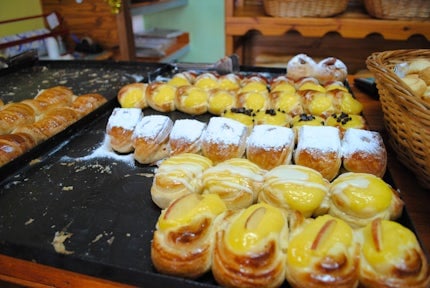
As you explore Argentina you won't be able to miss the fact that there is such great ice cream and delicious pastries everywhere! You'll come across homemade pizza and pasta throughout the country, plus ice cream parlours (serving very generous portions) on most town squares. The reason lies in the strong Italian heritage, which over 60% of Argentinians have some degree of.
In addition to Italian and Spanish immigrants, Argentina drew German, Swiss and Middle Eastern nationals. This melting pot of influences led to a thriving bread and pastry-making tradition. Little pastries or 'facturas' are stocked in most panaderías—loaded with 'membrillo' (quince jelly) or dulce de leche (sweetened milk/caramel) best guzzled by the dozen. Dulche de leche is a BIG favourite in Argentina, like manjar in Chile.
An Introduction to Chilean Food
Chilean-born chef Catalina guides you through some of her favourite cuisine from her home nation including options for vegetarians and wine lovers.
Swoop says

You can't go to Argentina without having a traditional asado as the steak is incredible - unless you're a vegetarian of course! Empanadas are a great option for lunch on the go, and they come with all kinds of fillings. In Chile, a delicious meal to try in summer is Pastel de Choclo, and make sure you don't miss out on their signature drink, the Pisco Sour!
Cecilia Paz Mesa Furniss Customer Experience Coordinator
Drinks in Argentina & Chile
An important part of any trip is staying refreshed—and that's very much the case in Patagonia.
You'll get to sample yerba mate as an alternative to your morning (afternoon and evening maybe) coffee, taste the purest water from glaciers and rivers on your hikes and excursions, while in the evening take advantage of crisp, cool beers and test some of the exquisite wine varieties grown further north in Chile and Argentina.
And don't forget the Calafate and Pisco Sours which are sure to keep you on your toes at night!
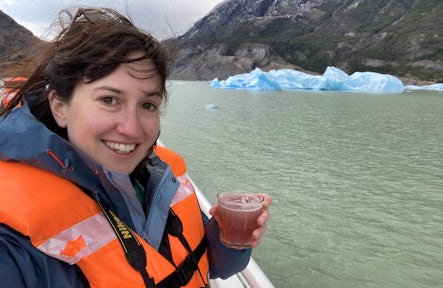
Carys from Team Swoop - Enjoying a Calafate Sour 'on ice'
Fernet & Coke
Arguably the national drink of Argentina, the Italian amaro liqueur, Fernet con coca (or Fernando), is served in a long glass over ice with a slice.
Fernet and Coke gained popularity due to its unique blend of the bitter herbal flavours of Fernet, which complement the sweetness of Coca-Cola, creating a distinctive and beloved national cocktail that has become a cultural phenomenon in the country.
This drink encapsulates the Argentine spirit, blending international influences with local tastes, and is often enjoyed during social gatherings, reflecting the country's warm and communal culture.
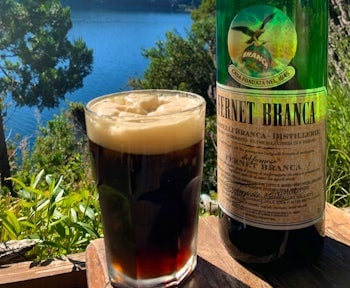
Wine
It goes without saying that a lot of people like to enjoy the picturesque landscapes of Patagonia, with a glass of wine in hand. It's also a social thing to enjoy with your friends at a meal.
In terms of taste - the region's cool climate imparts a unique character to its vineyards, producing crisp whites and robust reds. There are also normally options on the menu from the winemaking havens further north in Argentina and Chile.
The classic wine in Chile is Carmenere, which was exclusively cultivated in the country for many years. It's a must-try when visiting.
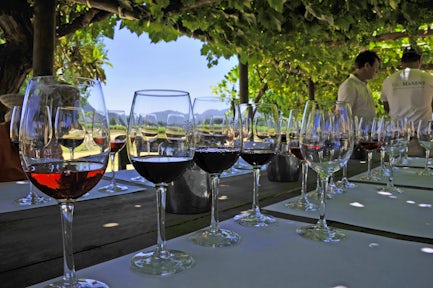
Visiting a winery in Colchagua valley, Chile
Pisco Sours
A cocktail that the Chileans claim as their national drink. Pisco liquor is mixed with lime juice, syrup, ice, egg white and Angostura bitters to make the exotic South American classic.
Chileans claim that Pisco was born in their country, however, Peruvians strongly disagree and claim it as their own. Whatever the truth may be, it is definitely something to try, or even a piscola (pisco and coca-cola).
Just watch out for the consequences the next morning!
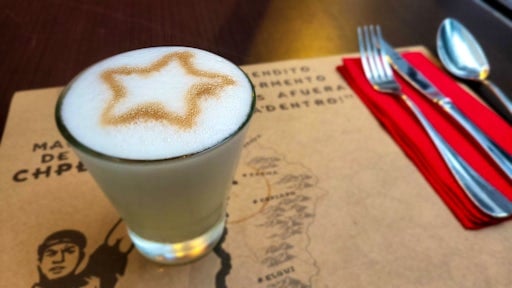
How to Make a Chilean Pisco Sour
Catalina returns to give you the lowdown on the lemon-flavoured lunchtime beverage that packs a nice sweet & sour punch.
Coffee
Picture yourself sipping a warm cup of freshly brewed coffee and gazing out to the majestic peaks, valleys or serene lakes of Patagonia...
Local coffee shops often boast unique blends, with beans sourced from various South American regions, offering a rich and hearty flavour that perfectly complements the rugged surroundings. Whether you're warming up after a day of adventure or simply soaking in the tranquil beauty, enjoying coffee here is a moment to savour.
In this remote and stunning region, coffee becomes more than just a drink; it's an experience.

Water
Chile and Argentina are very clean countries with very high levels of hygiene in most areas. A seasoned traveller would drink the tap water in both countries, but if you are just on a two-week holiday you might prefer not to risk it and stick with bottled water.
It's a good idea to take a water bottle as most hotels will have large drinking water containers from which you will be able to refill your bottle. All water in Torres del Paine and Los Glaciares National Parks is safe for consumption without filtering or boiling.
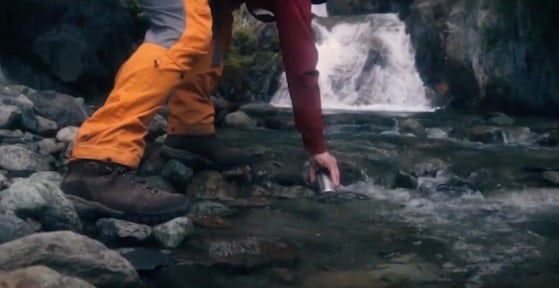
Mate
Pronounced 'mah-tay', yerba mate is a herbal, caffeine-infused social drink with its own special that is passed around a group. The caffeine content in mate can vary, but it's generally less than coffee yet higher than that found in most teas, offering a moderate energy boost without the jitters often associated with coffee.
It is prepared by filling a cup (traditionally a calabash gourd) with dried leaves of yerba, then covering the leaves with hot water and drinking it through a straw called a 'bombilla'. See our video below to ensure you're prepared for the ritual.
The average Argentinian consumes five kilos of mate a year. Let us know how it compares to your coffee and tea of choice back home!
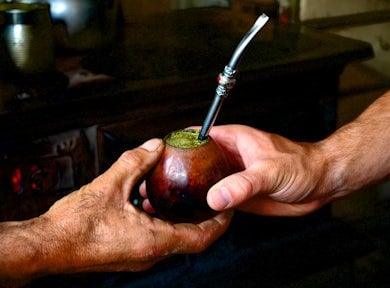
What is mate?
Hear from our very own Patagonian (and mate) expert, Danny, on what makes this bitter tasting tea so special and a cultural experience in its own right.
Swoop says

There is a whole etiquette around sharing mate. It's prepared by the Cebador, who drinks the first brew. He/she then hands the cup to his/her right – that person drinks the cup and then gives it back to the Cebador to refill. If you say gracias, it implies that you’ve had enough and you won’t be given another cup in the next round.
Danny Middleton Patagonia Specialist
Eating Out
Typically in Argentina and Chile, restaurants will serve food between 7pm and midnight.
During public holidays, they will have shorter opening hours and a lot of places will be closed - if travelling between Christmas and New Year, we would advise making a reservation and checking where is open.
Generally you will not need to book a table when going out for a meal. If you have seen a restaurant that you would like to eat in, there is no harm in making a reservation (this can usually be done online).
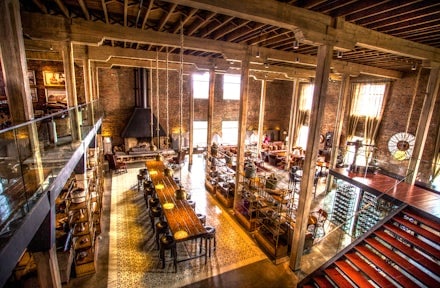
Restaurant Recommendations
After many years of travelling in Patagonia, we have eaten our way through the very best that Argentina and Chile have to offer. It's been hard to narrow it down but check out some of our favourite restaurant recommendations based on location...
-
Buenos Aires
Best for Authentic Argentina:
Cafe La Poesia (San Telmo): Known as the 'Poetry Cafe,' this literary institution in San Telmo is adorned with photos and writings of famous Argentine authors. Ideal for coffee, snacks, drinks, and shared platters known as picadas.
Best for Making the Most of Limited Time:
Fervor (Recoleta): A firm favourite in Recoleta, Fervor is renowned for serving up fresh fish and great steaks, making it a memorable dining experience.
Best for Steak & Wine:
Don Julio (Palermo): Indulge in excellent steaks, exceptional service, and a wonderful wine list at this Palermo establishment. Please note some tables are booked weeks in advance and that if you want to have lunch or dinner on the day, you may need to queue for hours.
Best for Vegetarians:
Buenos Aires Verde (Palermo): Known for its Incredible food and generous portions all with the concept of "intelligent nutrition."
Not to be missed:
A special mention must also go to Confiteria La Ideal—an iconic Buenos Aires establishment—that has reopened its doors after 7 years...
-
El Calafate
Best for Authentic Argentina:
La Tablita: A must-visit for anyone wanting to try Patagonian lamb slow-roasted over hot coals. Their mixed grill is delicious, accompanied by an extensive wine list, and they also serve great salads and roasted vegetables. The portions are big, so consider sharing. Arrive early or book ahead. Open daily.
Best for Steak & Wine:
La Zaina: Adorned with antique decor, this place boasts a great selection of wines by the glass, juicy steaks and delicious pasta dishes. It’s popular, so prepare to queue or book ahead. Closed Sundays.
Best for Vegetarians:
Pura Vida: Worth the short walk from the centre for its roaring fire and the gorgeous aroma of baking bread. If you fancy a change from steak, head here for creative vegetarian dishes, tasty stews and hearty meat pies. It’s on the main street a little out of the centre - it’s worth the walk, but book ahead. Closed Wednesdays.
-
El Chaltén
Best for Craft Beer & Pizza:
La Cerveceria Chaltén: Visit the original microbrewery in El Chaltén, where the inspirational host, Manu, provides insight into beer-making in Argentina's youngest town. The rustic ambience is ideal for post-trek drinks, offering a choice of delicious pizzas, pasta, or the classic Locro Stew. Daily from midday until late.
Best for Vegetarians:
Cúrcuma: A vegan's paradise in Patagonia, Cúrcuma makes being vegan easy with delicious salads, wraps, and fresh juices. They even prepare bagged lunches for your convenience.
Best for Wine & Tapas:
La Vineria: Run by local cycling legend Seba, La Vineria is Chaltén's original tapas and wine bar. Sample some of the best Argentine wines, including Patagonian Pinot Noirs, and enjoy the cosy atmosphere. Daily from midday until late.
-
Puerto Natales
Best for Chilean Cuisine:
Bahia Mansa: Exquisite locally sourced ingredients are crafted and presented perfectly for a wonderful dining experience. The wine list and desserts are superb. Closed Wednesdays.
Cormoran de las Rocas (A Swoop favourite): With fresh fish and delicious meats even including guanaco on the menu, this restaurant is a great bonus for Puerto Natales. Set up on the first floor of the building with incredible views over the Last Hope Sound.
Best for Seafood:
Santolla: Pay a visit to this converted shipping container for king crab, ceviche, scallops and fresh fish. Try their delicious Chilean wines and excellent Pisco Sours. It’s small, so arrive early (no reservations taken). Closed Sunday.
Best for Vegetarians:
Hablemos Coco: This cosy 100% vegan restaurant serves healthy and supremely tasty snacks, tapas, brunches and afternoon meals. The curries are fantastic! Daily until 7pm.
-
Puerto Varas
Best for Meat:
La Marca Recently relocated to the outskirts of the town, 2km away, this beautifully set restaurant is perfect for lovers of meat and all things roasted. The grills are all excellent, as well as the local dishes. We love the sopaipilla bread, which you can order to accompany your meal. It’s made in-house and is a tasty Chilean treat. Open Mon-Sat, 1pm-10pm.
Best for Seafood:
CasaValdés: One of Puerto Varas’s more elegant dining establishments and arguably the best restaurant in town, CasaValdés has tremendous views and a wonderful menu. The seafood is the speciality of the house, and everybody knows it, so book ahead because this place packs out! Ask for a table by the window so you can enjoy the sunset over the lake. Open Mon-Sat, 1pm-10pm.
Best for Vegetarians:
Daruma Tea House: A delightful place to while away the hours with a good coffee or tea while enjoying a book or light lunch. The fresh vegetarian dishes are great – we love the egg dishes and the variety of salads. Daily 7.30am-9pm.
-
Santiago
Best for Chilean Cuisine:
Borago (Vitacura): One of Santiago's most famous restaurants, with innovative tasting menus from 5-18 courses, providing a unique twist on traditional Chilean cuisine.
Best for Making the Most of Limited Time:
Baco (Providencia): Fantastic wine selection (particularly focusing on Chilean varieties), good for tapas-type food and great steaks. A blend of French and Chilean traditions.
Best for Something Special:
The 99 (Providencia): For many this is the restaurant in Santiago, offering a culinary experience beyond just dinner. Booking is essential.
Best for Vegetarians:
Restaurant El Huerto (Providencia): Offering only vegetarian and vegan options, this popular restaurant is situated just in front of the La Reve Hotel.
Best for Wine:
Bocanáriz (Lastarria): Indulge in the very best Chilean wines at Bocanáriz, where their unrivalled selection pairs perfectly with delicious food in the quirky neighbourhood of José Victorino Lastarria.
Dietary Considerations
Allergies & Intolerances
If you have a serious food allergy, you should approach your time in Patagonia with caution, especially in remote locations. While our partners on the ground will do their best to cater to your needs, they'll not be used to being as fastidious and careful as you may need to be on a day-to-day basis. Celiacs might not always have many options, especially outside of larger cities.
If you are concerned about your time in hotels, towns or cities, or on board an adventure cruise, we'd suggest speaking with the hotel or ship manager and getting a message to the head chef or head waiter as early on in the experience as possible.
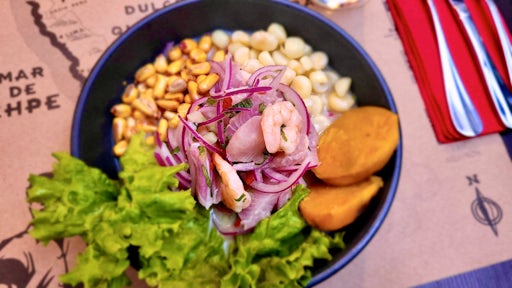
What if I don't eat meat?
Travellers who don't eat meat can still enjoy a rich culinary experience with a variety of vegetarian and vegan options available.
A growing number of restaurants, cafes and eateries offer plant-based dishes, including fresh salads, flavourful wraps, and inventive vegan alternatives. In some cases, they are the highlight of the menu.
Exploring the vibrant food scene in Buenos Aires or Santiago and towns like El Chaltén or Puerto Natales reveals a range of veg-friendly choices, ensuring non-meat eaters can still savour the tastes of Patagonia while respecting their dietary preferences.
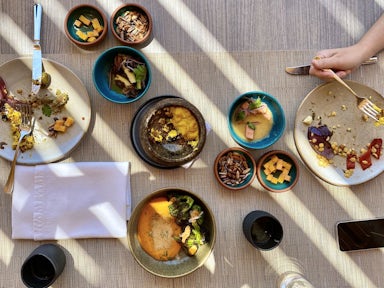
Experiencing Patagonia as a Vegetarian
Given Patagonia is renowned for its meat-eating culture, what is it like to travel there as a vegetarian? Our videographer finds out.








